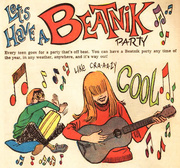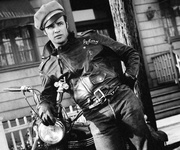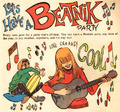
The scene on Third Street outside Rick Allmen’s Café Bizarre, November 11, 1959. Photo: Bettmann/Getty Images.
America hit peak hippie in 1967, thanks to the avalanche of media hype that accompanied the Summer of Love. In contrast, there was no single catalyzing event to mark the moment when our nation reached peak beat, although one could make a good case for 1959.
“At the remove of time, it’s really hard to tell the difference between beat and beatsploitation.”
My colleague Hunter Oatman-Stanford essentially did that a few years ago in an article titled “Cool for Sale, From Beatnik Bongos to Hipster Specs.” In that piece, he noted that 1959 was the year when TV viewers were introduced to Maynard G. Krebs, the loveable beatnik sidekick to straight-arrow suburbanite Dobie Gillis. It was also the year editors at “Life” magazine thought its readers were ready for a comparison of life in Hutchinson, Kansas, and Venice Beach, California, dubbing their photo-heavy exposé “Squaresville U.S.A. vs. Beatsville.” Cool, daddy-o.

A copy of “Assorted Madness” in good condition will fetch between $250 and $300, a sum that would have seemed like madness itself when the record was pressed in 1959. Photo: Manuera.com.
The Manhattan editors at “Life” could have saved themselves the trouble of flying a team of reporters and photographers clear across the country by simply hopping a subway car for Greenwich Village, the East Coast capital of beat culture. And their first stop may well have been a coffeehouse called Café Bizarre, which had opened in 1957 to cash in on the folk and poetry scene. By 1959, café owner Rick Allmen was hawking copies of a private-label LP titled “Assorted Madness,” which promised “Beat Erotica” on its cover and featured earnest poetry and desultory music by some of the café’s most infamous denizens.
One of those denizens was Rafio the Mad Monk, a.k.a. Walter Brooks, who preached his occasionally sacrilegious love poems to customers sharing a “Suffering Bastard Sundae” ($4.75, serves four) or tucking into a “Cannibal” sandwich (raw chopped steak and a raw egg on your choice of rye, white, or Russian pumpernickel for $1.50). A few of Rafio’s poems are featured on “Assorted Madness.” They are among the most listenable minutes on the otherwise forgettable album.

Pat and Rafio, on the beach in Provincetown, 1959. Photo: Pat Brooks.
Brooks passed away in 2018 at the age of 87, but his wife, Pat, who dropped out of high school in 1959 at the tender age of 17 to become Rafio’s girlfriend, remembers well Café Bizarre and the day she met the man who would become her husband of almost 60 years.
“It was pretty funny,” Brooks tells me over the phone. “I was born on Cape Cod, but my parents moved to Sturbridge, Massachusetts, which is maybe a couple hundred miles from the Cape. On weekends, I used to hitchhike with my girlfriends to Provincetown because my father had a little cottage in Truro nearby. We would walk all around Provincetown and do what teenagers do.
“One day,” Brooks continues, “I noticed Rafio looking at me from a distance. He didn’t say anything to me because he was about 12 or 13 years older. This went on for a couple of weekends. On one of those weekends, I was walking down the street with a girlfriend and I passed a table with a good-looking art folder and small easel on it. I peeked at one of the pieces inside and thought, ‘Oh, this is really beautiful.’ So I looked around to make sure no one was watching, put the easel under my arm, and kept walking. Rafio had been riding his bicycle, and when he saw me from a distance, he noticed I had an easel under my arm and thought, ‘Oh, she’s an artist, too.’ But as we got closer, he realized the easel was his. That’s how we met.”

A poetry reading at Café Bizarre, 1961. Photo: New York Times Co./Getty Images.
It was a meeting that would change both of their lives. “I was in my senior year of high school,” Brooks recalls. “I eventually quit school, boarded a Greyhound bus, and met him in the Village. He was a poet at Café Bizarre and I became a waitress. I passed the hat after every one of his readings,” usually in a uniform of a leotard “and little else,” as her husband remembered it in a blog post published in 2010.
Needless to say, her parents were not exactly thrilled by this turn of events. “Oh yeah,” Brooks says with a laugh. “They drove to New York City and went to a police station to report a missing teenager, but the officers just said, ‘We get these all the time.’ But you know what? My parents ended up liking Rafio as much, or better, than me, so it all worked out.”
Despite not having a regular place to stay—“We were living from couch to couch,” she says—Brooks has fond memories of her years in the Village and at Café Bizarre. (The couple eventually settled back on the Cape, where they successfully ran a publishing business.) “Oh, it was wonderful,” she says. “It was very lively, with colorful banners. It was right up there with The Gaslight and Cafe Wha, although Café Bizarre was more commercial than those places.”

The back of the Café Bizarre menu featured a map, as well as an odd list of events they catered. Photo: WorthPoint.
In particular, Brooks remembers how “nice” girls from the Bronx would come down on weekends to hang out. In fact, all sorts of people passed through the doors of Café Bizarre. “At one time or another, everyone who was anyone in the beat movement showed up there,” music journalist John Marks says. “It’s almost a certainty that people like Jack Kerouac and Allen Ginsberg visited Café Bizarre, although,” he adds, “probably only once.”
That’s why you won’t find poets like Kerouac and Ginsberg on “Assorted Madness,” a record Marks is quite familiar with, beginning with its scarcity. “According to an international database of academic and research libraries called WorldCat,” he tells me, “there is no library in the world that has ‘Assorted Madness’ in its collection. In a way, that makes sense because this kind of blasphemous, vulgar, disjointed album was not the sort of thing academic libraries—and especially public libraries—were adding to their collections. There’s some really ugly misogynist material on there.”

Left: Odetta, seen here in 1957, was the opening-night performer at Café Bizarre. Photo: Universal History Archive/Universal Images Group via Getty Images. Right: Dave Van Ronk, seen here on the stage of The Gaslight in 1964, formed the Folksingers Guild in response to the meager fees he and others were receiving at Café Bizarre. Photo: Kai Shuman/Michael Ochs Archives/Getty Images.
That wouldn’t have been the case on the opening night of Café Bizarre in 1957, when Odetta was the venue’s debut performer. Other singers who played there that year included Dave Van Ronk, who started the Folksingers Guild with some friends in large part because of the paltry sums he and others were earning at Café Bizarre (singers were paid in tips). Van Ronk was frustrated because, as he told the authors of Folk City, “Rick Allmen was the sole capitalist on the scene,” albeit, he added, a feckless one.
“Assorted Madness” is a good example of Allmen’s fecklessness. “There’s none of the usual stuff you’d expect to see on a commercially released LP,” Marks says. “There isn’t even lettering on the spine of the LP jacket. It was a pretty amateur production.” Even so, a copy of “Assorted Madness” brings more today than the enterprising Allmen could have predicted. “A record and jacket in good shape is worth $250 to $300, all day, every day,” Marks says. “There are only a handful of these things out there.”

John Cale (left) and Lou Reed (right) of the Velvet Underground were discovered by Andy Warhol at Café Bizarre in December 1965. Photo: Adam Ritchie/Redferns/Getty Images.
As it turned out, “Assorted Madness” was not Café Bizarre’s most influential record-related product. In 1965, several years after Rafio the Mad Monk had stopped reciting poetry at Café Bizarre, Andy Warhol and his entourage wandered into the place to catch a band called the Velvet Underground, an encounter that would have a far greater impact on the record industry than “Assorted Madness.”
Even so, “Assorted Madness” remains an important artifact of peak beat. “It’s entirely possible that ‘Assorted Madness’ was pressed to generate a little revenue while having a laugh at the straights who were paying good money for this silly LP,” Marks says. “At the remove of time, it’s really hard to tell the difference between beat and beatsploitation.”
(If you buy something through a link in this article, Collectors Weekly may get a share of the sale. Learn more.)

 Why Nerdy White Guys Who Love the Blues Are Obsessed With a Wisconsin Chair Factory
Why Nerdy White Guys Who Love the Blues Are Obsessed With a Wisconsin Chair Factory
 Cool for Sale, From Beatnik Bongos to Hipster Specs
Cool for Sale, From Beatnik Bongos to Hipster Specs Why Nerdy White Guys Who Love the Blues Are Obsessed With a Wisconsin Chair Factory
Why Nerdy White Guys Who Love the Blues Are Obsessed With a Wisconsin Chair Factory Made for Misfits: The Colorful History of the Black Leather Jacket
Made for Misfits: The Colorful History of the Black Leather Jacket Private and Promo RecordsBefore a vinyl record was released to the public, a small number of copies …
Private and Promo RecordsBefore a vinyl record was released to the public, a small number of copies … Poetry BooksWhether your taste tends to William Shakespeare, William Blake, or William …
Poetry BooksWhether your taste tends to William Shakespeare, William Blake, or William … Mari Tepper: Laying it on the Line
Mari Tepper: Laying it on the Line Nice Ice: Valerie Hammond on the Genteel Charm of Vintage Canadian Costume Jewelry
Nice Ice: Valerie Hammond on the Genteel Charm of Vintage Canadian Costume Jewelry How Jim Heimann Got Crazy for California Architecture
How Jim Heimann Got Crazy for California Architecture Modernist Man: Jock Peters May Be the Most Influential Architect You've Never Heard Of
Modernist Man: Jock Peters May Be the Most Influential Architect You've Never Heard Of Meet Cute: Were Kokeshi Dolls the Models for Hello Kitty, Pokemon, and Be@rbrick?
Meet Cute: Were Kokeshi Dolls the Models for Hello Kitty, Pokemon, and Be@rbrick? When the King of Comedy Posters Set His Surreal Sights on the World of Rock 'n' Roll
When the King of Comedy Posters Set His Surreal Sights on the World of Rock 'n' Roll How One Artist Makes New Art From Old Coloring Books and Found Photos
How One Artist Makes New Art From Old Coloring Books and Found Photos Say Cheese! How Bad Photography Has Changed Our Definition of Good Pictures
Say Cheese! How Bad Photography Has Changed Our Definition of Good Pictures Middle Earthenware: One Family's Quest to Reclaim Its Place in British Pottery History
Middle Earthenware: One Family's Quest to Reclaim Its Place in British Pottery History Fancy Fowl: How an Evil Sea Captain and a Beloved Queen Made the World Crave KFC
Fancy Fowl: How an Evil Sea Captain and a Beloved Queen Made the World Crave KFC
I am Rick Allmen’s daughter, Dr. Tara Allmen.